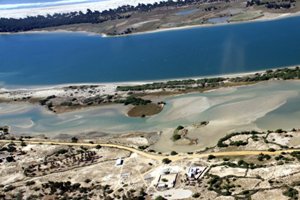Case-study /
Senegal: Sea-Level Rise and Impacts in Africa, 2000 to 2100. Application of the DIVA model to Africa.


Coast of Senegal, south of Saint-Louis. Image: ©panoramio.com
Impacts of sea-level rise in Senegal
Senegal has a coast of 2,065km comprising sandy, deltaic (the Senegal delta in the north), estuarine (Saloum and Casamance estuaries) coasts and small lengths of rocky shoreline (Dennis et al., 1995). The country has a tropical boreal type climate. More than half of the Senegalese population (4 million people in 1990) and most of the economic activity are within a 70km strip of the coastal zone (Dennis et al., 1995). A preliminary study by Niang (1990) showed that with sea-level rise Senegal ould experience significant risks of inundation in the delta and estuaries, and erosion along the sandy coastlines. In general, independent of the sea-level rise scenario considered, 95% of the land loss in the coastal zone for the Saloum and Casamance estuaries and the Senegal delta) is caused by inundation (Dennis et al., 1995; Zinyowera et al., 1998). However, erosion could also severely affect the growing international tourism industry by damaging coastal structures and beaches. A 1m sealevel rise could inundate and erode more than 6,000km2 of land, mostly wetlands (such as mangroves and spawning grounds for fish) in the Senegalese delta, and the Saloum and Casamance estuaries. Agriculture areas, major economic activities particularly in the deltaic region where rice and sugar cane is grown, would also be threatened (Dennis et al., 1995).
In developed areas, accelerated erosion due to sea-level rise could cost more than US$500-US$700 million (12-17% of the country’s GDP at 1995 values) out of which 20-30% represents tourist facilities at risk. It is also estimated that 110,000-180,000 people (1.4% to 2.3% of the 1990 population) could be displaced, the majority of which are located south of the Cap Vert Peninsula. Protection, such as sea walls and beach nourishment, would cost US$255-US$845 million (0.7-2.2% of the country’s GDP) over a fifty year period. Beach nourishment is a favoured option, as this would help to maintain the tourist industry, which accounts for around 3% of the GDP (Dennis et al., 1995).
Suggested citation
Brown, S., Kebede, A.S., and Nicholls, R.J. (2011). Sea-Level Rise and Impacts in Africa, 2000 to 2100. University of Southampton, UK, 215pp
